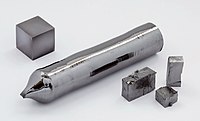
Photo from wikipedia
Failure of porous tantalum rod (PTR) implantation in treating early osteonecrosis of femoral head (ONFH) has been frequently reported, but the underlying mechanism remains uncertain, which raised the concern of… Click to show full abstract
Failure of porous tantalum rod (PTR) implantation in treating early osteonecrosis of femoral head (ONFH) has been frequently reported, but the underlying mechanism remains uncertain, which raised the concern of its efficacy. The study aimed to discuss the underlying mechanism from the perspectives of bone reconstruction and pathological changes. Five patients with PTR implantation experienced total hip arthroplasty (THA) due to recurrent pain, whose femoral heads were collected as “tantalum group.” Normal (fracture) and necrotic femoral heads were respectively collected (both n = 5) after THA. The bone quality and structure, biomechanical properties, and histopathological features were analyzed by micro-CT scanning, mechanical measurement, and histological examination. Both the tantalum group and necrotic group had significantly poorer bone quantity and quality than the normal group. Three-dimensional imaging reconstruction showed that the trabeculae of the tantalum group were poorest in quality. Significant differences in terms of bone quality, structure, and biomechanical properties were present between the inside and outside regions around PTR, which revealed abnormal bone reconstruction. Biomechanical analysis revealed inferior properties in the tantalum group and necrosis group. H&E staining demonstrated neutrophil infiltration among the peripheral trabeculae around PTR, and the inflammation cells were significantly more abundant than that in the normal and necrosis groups. Abnormal bone reconstruction around PTR was an important cause for failure of PTR implantation in the treatment of ONFH, which was related to biomechanical stress distribution and chronic inflammation infiltration. Insufficient biomechanical support and inflammatory trabeculae edema might account for the recurrent pain.
Journal Title: International Orthopaedics
Year Published: 2022
Link to full text (if available)
Share on Social Media: Sign Up to like & get
recommendations!